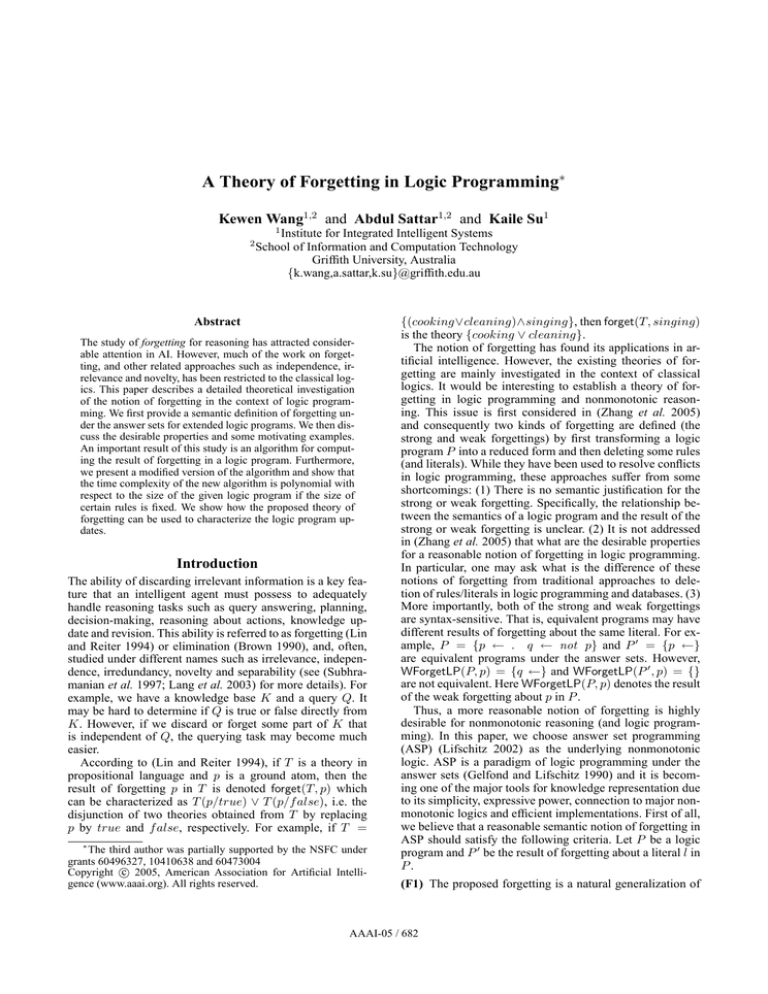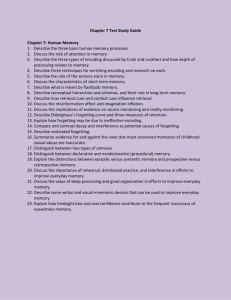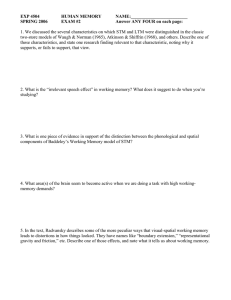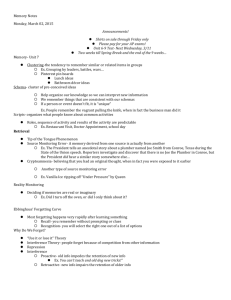
A Theory of Forgetting in Logic Programming∗
Kewen Wang1,2 and Abdul Sattar1,2 and Kaile Su1
1
2
Institute for Integrated Intelligent Systems
School of Information and Computation Technology
Griffith University, Australia
{k.wang,a.sattar,k.su}@griffith.edu.au
Abstract
The study of forgetting for reasoning has attracted considerable attention in AI. However, much of the work on forgetting, and other related approaches such as independence, irrelevance and novelty, has been restricted to the classical logics. This paper describes a detailed theoretical investigation
of the notion of forgetting in the context of logic programming. We first provide a semantic definition of forgetting under the answer sets for extended logic programs. We then discuss the desirable properties and some motivating examples.
An important result of this study is an algorithm for computing the result of forgetting in a logic program. Furthermore,
we present a modified version of the algorithm and show that
the time complexity of the new algorithm is polynomial with
respect to the size of the given logic program if the size of
certain rules is fixed. We show how the proposed theory of
forgetting can be used to characterize the logic program updates.
Introduction
The ability of discarding irrelevant information is a key feature that an intelligent agent must possess to adequately
handle reasoning tasks such as query answering, planning,
decision-making, reasoning about actions, knowledge update and revision. This ability is referred to as forgetting (Lin
and Reiter 1994) or elimination (Brown 1990), and, often,
studied under different names such as irrelevance, independence, irredundancy, novelty and separability (see (Subhramanian et al. 1997; Lang et al. 2003) for more details). For
example, we have a knowledge base K and a query Q. It
may be hard to determine if Q is true or false directly from
K. However, if we discard or forget some part of K that
is independent of Q, the querying task may become much
easier.
According to (Lin and Reiter 1994), if T is a theory in
propositional language and p is a ground atom, then the
result of forgetting p in T is denoted forget(T, p) which
can be characterized as T (p/true) ∨ T (p/f alse), i.e. the
disjunction of two theories obtained from T by replacing
p by true and f alse, respectively. For example, if T =
∗
The third author was partially supported by the NSFC under
grants 60496327, 10410638 and 60473004
c 2005, American Association for Artificial IntelliCopyright gence (www.aaai.org). All rights reserved.
{(cooking∨cleaning)∧singing}, then forget(T, singing)
is the theory {cooking ∨ cleaning}.
The notion of forgetting has found its applications in artificial intelligence. However, the existing theories of forgetting are mainly investigated in the context of classical
logics. It would be interesting to establish a theory of forgetting in logic programming and nonmonotonic reasoning. This issue is first considered in (Zhang et al. 2005)
and consequently two kinds of forgetting are defined (the
strong and weak forgettings) by first transforming a logic
program P into a reduced form and then deleting some rules
(and literals). While they have been used to resolve conflicts
in logic programming, these approaches suffer from some
shortcomings: (1) There is no semantic justification for the
strong or weak forgetting. Specifically, the relationship between the semantics of a logic program and the result of the
strong or weak forgetting is unclear. (2) It is not addressed
in (Zhang et al. 2005) that what are the desirable properties
for a reasonable notion of forgetting in logic programming.
In particular, one may ask what is the difference of these
notions of forgetting from traditional approaches to deletion of rules/literals in logic programming and databases. (3)
More importantly, both of the strong and weak forgettings
are syntax-sensitive. That is, equivalent programs may have
different results of forgetting about the same literal. For example, P = {p ← . q ← not p} and P 0 = {p ←}
are equivalent programs under the answer sets. However,
WForgetLP(P, p) = {q ←} and WForgetLP(P 0 , p) = {}
are not equivalent. Here WForgetLP(P, p) denotes the result
of the weak forgetting about p in P .
Thus, a more reasonable notion of forgetting is highly
desirable for nonmonotonic reasoning (and logic programming). In this paper, we choose answer set programming
(ASP) (Lifschitz 2002) as the underlying nonmonotonic
logic. ASP is a paradigm of logic programming under the
answer sets (Gelfond and Lifschitz 1990) and it is becoming one of the major tools for knowledge representation due
to its simplicity, expressive power, connection to major nonmonotonic logics and efficient implementations. First of all,
we believe that a reasonable semantic notion of forgetting in
ASP should satisfy the following criteria. Let P be a logic
program and P 0 be the result of forgetting about a literal l in
P.
(F1) The proposed forgetting is a natural generalization of
AAAI-05 / 682
classical one: T (p/true) ∨ T (p/f alse).
(F2) No new symbol is introduced in P 0 .
(F3) The reasoning under P 0 is equivalent to the reasoning
under P if l is ignored.
(F4) The definition of forgetting is not syntax-sensitive.
That is, the results of forgetting about l in equivalent programs are also equivalent.
(F5) The semantic notion of forgetting should be coupled
with a syntactic counterpart.
(F1) specifies the major intuition behind forgetting and clarifies the difference of forgetting from deletion; (F2) is necessary because the forgetting is to eliminate redundant symbols. This is a difference of forgetting from some approaches
to revision, update and merging (it is another issue to combine forgetting with other approaches to adding new information); (F3) provides a semantic justification for the forgetting. Note that P 0 and P may have different answer sets
in general (see Proposition 3); (F4) guarantees the notion of
forgetting is well-defined. (F5) is useful for applications of
forgetting in knowledge representation.
To our best knowledge, there is no theory of forgetting
in nonmonotonic reasoning or logic programming which is
based on the above criteria. However, the definition of forgetting in classical logic cannot be directly translated to
logic programming. For example, if P is a logic program,
P (p/true)∨P (p/f alse) is not even a logic program in general. Moreover, as we will see later, it is not straight forward
to replace P (p/true) ∨ P (p/f alse) by an appropriate logic
program.
In this paper, we first introduce a notion of forgetting in
answer set programming and then show that this notion of
forgetting satisfies the above criteria (F1)-F(4) as well as
some other attracting properties (e.g. Theorem 1). Thus our
notion of forgetting captures the classical notion of forgetting. To justify (F5), we then develop an algorithm for computing the result of forgetting in a given logic program; and a
variant of the algorithm that is polynomial time if the size of
certain rules is fixed. These results illustrate that our notion
of forgetting possesses all major properties of classical forgetting. The proposed theory of forgetting provides a general
framework for reasoning tasks such as merging, update and
revision of logic programs. As an example, we show how to
capture the update answer sets (Eiter et al. 2002) by using
our theory of forgetting. Our study also shows that developing a semantic theory of forgetting for logic programs is a
non-trivial task.
Preliminaries
We deal with extended logic programs (Gelfond and Lifschitz 1990) whose rules are built from some atoms where
default negation not and strong negation ¬ are allowed. A
literal is either an atom a or its strong negation ¬a. For any
atom a, we say a and ¬a are complementary literals. For any
set X of literals, not X = {not l | l ∈ X}.
An extended logic program is a finite set of rules of the
following form
l0 ← l1 , . . . , lm , not lm+1 , . . . , not ln
(1)
where l0 is either a literal or empty, each li is a literal for
i = 1, . . . , n, and 0 ≤ m ≤ n. If l0 is empty, then the rule is
a constraint.
Without loss of generality, we consider propositional programs. For technical reasons, it should be stressed that the
body of a rule is a set of literals rather than a multiset. For
instance, a ← not b, c, c is not a rule in our sense while
a ← not b, c is a rule. That is, we assume that any rule of
a logic program has been simplified by eliminating repeated
literals in its body.
If a rule of form (1) contains no default negation, it is
called positive; P is a positive program if every rule of P is
positive.
If a rule of form (1) contains no body atoms, it is called
negative; P is a negative program if every rule of P is negative.
Given a rule r of form (1), head (r) = l0 and body(r) =
body + (r) ∪ not body − (r) where body + (r) = {l1 , . . . , lm },
body − (r) = {lm+1 , . . . , ln }. The set head (P ) consists of
all literals appearing in rule heads of P .
In the rest of this section we assume that P is an extended
logic program and X is a set of literals. A rule r in P is
satisfied by X, denoted X |= r, iff “if body + (r) ⊆ X and
body − (r) ∩ X = ∅, then head (r) ∈ X”. X is a model of P ,
denoted X |= P if every rule of P is satisfied by X.
The answer set semantics The reduct of logic program
P on a set X of literals, written P X , is obtained as follows:
• Delete every r from P such that there is a not q ∈
body − (r) with q ∈ X.
• Delete all negative literals from the remaining rules.
Notice that P X is a set of rules without any negative literals. Thus P X may have no model or have a unique minimal
model, which coincides with the set of literals that can be
derived by resolution.
X is a answer set of P if X is the minimal model of P X .
A logic program may have zero, one or more answer sets.
We use k P k to denote the collection of answer sets of P .
A program is consistent if it has at least one answer set.
Two logic programs P and P 0 are equivalent, denoted
P ≡ P 0 , if they have the same answer sets.
As usual, BP is the Herbrand base of logic program P ,
that is, the set of all (ground) literals in P .
Forgetting in Logic Programming
In this section we introduce a semantic definition of forgetting for extended logic programs. That is, we want to define
what it means to forget about a literal l in a logic program P .
The intuition behind the forgetting theory is to obtain a logic
program which is equivalent to the original logic program if
we ignore the existence of the literal l.
It is direct to forget a literal l in a set X of literals, that is,
just remove l from X if l ∈ X. This notion of forgetting can
be easily extended to subsets. A set X 0 is an l-subset of X
if X 0 − {l} ⊆ X − {l}. Similarly, a set X 0 is a true l-subset
of X if X 0 − {l} ⊂ X − {l}.
Two sets X and X 0 of literals are l-equivalent, denoted
X ∼l X 0 , iff (X − X 0 ) ∪ (X 0 − X) ⊆ {l}.
AAAI-05 / 683
Given a consistent logic program P and a literal l, we
could define a result of forgetting about l in P as an extended logic program P 0 whose answer sets are exactly
k P k −l = {X − {l} | X ∈k P k}. However, such a
notion of forgetting cannot even guarantee the existence for
some simple programs. For example, consider P = {a ←
. p ← not q. q ← not p}, then k P k= {{a, p}, {a, q}}
and thus k P k −p = {{a}, {a, q}}. Since {a} ⊆ {a, q}
and each answer set must be minimal, k P k −p cannot
be the set of answer sets of any logic program. So we need
a notion of minimality of answer sets which can naturally
combine the definition of answer sets, minimality and forgetting together.
Definition 1 Let P be a consistent logic program, l a literal
in P and X a set of literals.
1. We say X is l-minimal in a collection S of sets of literals
if X ∈ S and there is no X 0 ∈ S such that X 0 is a true lsubset of X . In particular, if SP is the set of models of P ,
then we say X is an l-minimal model of a logic program
P if X is a model of P and it is l-minimal in SP .
2. X is an answer set of P by forgetting l (briefly, l-answer
set) if X is an l-minimal model of the reduct P X .
For P = {a ← . q ← not p. p ← not q}, it has two
answer sets X = {a, p} and X 0 = {a, q}. X is a p-answer
set of P but X 0 is not. This example shows that, for a logic
program P and a literal l, an answer set may not be an lanswer set.
Having the notion of minimality about forgetting a literal,
we are now in a position to define the result of forgetting
about a literal in a logic program.
Definition 2 Let P be a consistent logic program and l be
a literal. A logic program P 0 is a result of forgetting about l
in P if the following conditions are satisfied:
1. BP 0 ⊆ BP − {l}.
2. For any set X 0 of literals, X 0 is an answer set of P 0 iff
there is an l-answer set X of P such that X 0 ∼l X.
Notice that the first condition implies that l does not appear
in P 0 . In particular, no new symbol is introduced in P 0 .
A logic program P may have different logic programs as
results of forgetting about the same literal l. However, it follows from the above definition that any two results of forgetting about the same literal in P are equivalent under the
answer set semantics.
Proposition 1 Let P be an extended logic program and l a
literal in P . If P 0 and P 00 are two results of forgetting about
l in P , then P 0 and P 00 are equivalent (i.e. they have the
same answer sets).
We use forget(P, l) to denote the result of forgetting about l
in P .
Examples
1. If P1 = {q ← not p}, then forget(P1 , p) = {q ←} and
forget(P1 , q) = {}.
2. If P2 = {q ← not p. p ← not q}, then forget(P2 , p) =
{q ← q}. The reason is that P2 has two answer sets
{p} and {q} but only {p} is a p-answer set of P2 . Thus
forget(P2 , p) has a unique answer set {}.
3. Consider P3 = {q ← not p. p ←}, which has the
unique answer {p}. Thus forget(P3 , p) = {} rather than
{q ←}. This is intuitive because we are forgetting all impacts of p on P3 . In particular, “forgetting about p” is different from “assuming not p”.
4. Let P4 = {a ← not b. b ← not a. p ←
not a. c ← not p}. According to (Zhang et al.
2005), the weak forgetting WForgetLP(P4 , p) = {a ←
not b. b ← not a. c ←}; the strong forgetting of
SForgetLP(P4 , p) = {a ← not b. b ← not a}. However, forget(P4 , p) = {a ← not b. b ← not a. c ←
a}.
In the next section we will explain how to obtain
forget(P, l). The following proposition generalizes 1 and
shows that the criteria (F4) is satisfied.
Proposition 2 Let P and P 0 be two equivalent logic
programs and l a literal in P . Then forget(P, l) and
forget(P 0 , l) are also equivalent under the answer sets.
Now we show that our notion of forgetting does satisfy
(F3).
Proposition 3 For any consistent program P and a literal l
in P , the following two items are true:
1. An l-answer set X of P must be an answer set of P .
2. For any answer set X of P , there is an l-answer set X 0 of
P such that X 0 ⊆ X.
This result implies that, if l is ignored, forget(P, l) is equivalent to P under both credulous and skeptical reasoning with
respect to the answer set semantics.
Let lcomp(P ) be Clark’s completion plus the loop formulas for P . Then it is shown in (Lin and Zhao 2004) that X
is an answer set of P iff X is a model of lcomp(P ) (in the
classical logic).
Theorem 1 Let P be a logic program and l a literal in P .
Then
lcomp(forget(P, l)) ≡ forget(lcomp(P ), l).
This result means that the answer sets of forget(P, l) are exactly the models of the result of forgetting about l in the
classical theory lcomp(P ). Thus forget(P, l) can be intuitively and completely characterized by the classical forgetting. Notice that it would not make much sense if we replace
lcomp(P ) with a classical theory which is not equivalent to
lcomp(P ) in Theorem 1.
The above definitions of forgetting about a literal l can
be extended to forgetting about a set F of literals. Specifically, we can similarly define X1 ⊆F X2 , X1 =F X2 and
F -answer sets of a logic program. Those properties of forgetting about a single literal can also be generalized to the
case of forgetting about a set. Moreover, the result of forgetting about a set F can be obtained one by one forgetting
each literal in F .
Proposition 4 Let P be a consistent program and F = F 0 ∪
{l}. Then
AAAI-05 / 684
forget(P, F ) ≡ forget(forget(P, l), F 0 ).
Computation of Forgetting
Since Definition 2 is a semantic one, it does not guarantee the existence of the result of forgetting about l in P .
So one important issue is to study the problem of computing the result of forgetting. In the following we will justify
the criterion (F5) by developing algorithms for computing
forget(P, l) using program transformations. The basic idea
is to equivalently transform the original program P into a
standard form N first and then to obtain forget(P, l) directly
from N .
Program transformations
The program transformations in this section are introduced
in (Brass et al. 2001). P and P 0 are extended logic programs.
Elimination of Tautologies P 0 is obtained from P by the
elimination of tautologies if there is a rule r in P such
that head (r) ∈ body + (r) and P 0 = P − {r}.
Positive Reduction P 0 is obtained from P by the positive
reduction if there is a rule r in P and c ∈ body − (r) such
that c 6∈ head (P ) and P 0 is obtained from P by removing
not c from r.
0
Negative Reduction P is obtained from P by negative reduction if there are two rules r and r0 in P such that
body(r0 ) = ∅ and head (r0 ) ∈ body − (r). and P 0 =
P − {r}.
Let r and r0 be two distinct rules in a logic program. We
say r0 is an implication of r if head (r) = head (r0 ) and
body(r) ⊂ body(r0 ).
Elimination of Implications P 0 is obtained from P by the
elimination of implications if there are two distinct rules
r and r0 of P such that r0 is an implication of r and P 0 =
P − {r0 }.
For two rules r and r0 with head (r0 ) ∈ body + (r), the
unfolding of r with r0 , denoted unfold (r, r0 ), is the rule
head (r) ← (body(r) − {head (r0 )}), body(r0 ).
Unfolding P 0 is obtained from P by unfolding if there is a
rule r such that
P
0
=
P − {r}
∪{unfold (r, r0 ) | r0 ∈ P, head (r0 ) ∈ body + (r)}.
T denotes the set of the program transformations introduced
above.
Lemma 1 (Brass et al. 2001) Every logic program can be
transformed into a canonical form by T , which is a negative
program.
This lemma is also true for extended logic programs.
Algorithms for Computing forget(P, l)
We are now ready to present our basic algorithm for computing a result of forgetting about a given literal in a logic
program.
Algorithm 1 (Computing a result of forgetting)
Input: logic program P and a literal l.
Procedure:
Step 1. Transform P into its canonical form N .
Step 2. Suppose that N has n rules having head l (but
body does not contain l due to the Elimination of tautology)
where n ≥ 0:
rj : l ← not lj1 , ..., not ljmj
where j = 1, . . . , n and mj ≥ 0 for all j.
If n = 0, then N 0 is the program obtained from N by
removing all appearances of not l.
If n = 1 and m1 = 0, then l ← is the only rule in N
having head l. In this case D1 is defined as false.
If n ≥ 1 and m1 > 0, then mi > 0, for i = 1, . . . , s,
by the Elimination of implications. Let D1 , . . . , Ds be all
possible conjunctions (l1k1 , · · · , lnkn ) where 0 ≤ k1 ≤ m1 ,
..., 0 ≤ kn ≤ mn .
Replace every appearance of not l in rule bodies of N by
all possible Di and the resulting program is denoted Q.
Step 3. Remove all rules with head l from Q and the resulting program is denoted N 0 .
Output N 0 as forget(P, l).
Theorem 2 For any consistent program P and a literal l,
Algorithm 1 always returns a result of forgetting about l in
P.
Before we present a proof sketch of Theorem 2, first consider two examples.
Example 1 Let P = {a ← not b. b ← not a. c ←
not b. p ← not a, not c. d ← not p}. Since P is a
negative program, we can directly get forget(P, p) = {a ←
not b. b ← not a. c ← not b. d ← a. d ← c}
Consider another program for which program transformations are needed.
Example 2 Let P = {p ← not p1 . p ← p, not q1 . p ←
p1 , not q1 . p1 ← not p2 . p1 ← p2 , not q}. Then it can
be equivalently transformed into the program N = {p ←
. p1 ←}. So forget(P, p) = {p1 ←}, forget(P, q) = {p ←
. p1 ←}, forget(P, p1 ) = {p ←}.
For some special programs, it can be easier to compute
forget(P, l).
Corollary 3 Let P be a consistent program and N be the
canonical program obtained from P by T . Then
1. If l ∈ X for every X ∈k P k, then forget(P, l) is the
program obtained from N by removing all rules containing l. In this case, forget(P, l) coincides with the strong
forgetting defined in (Zhang et al. 2005).
2. If l 6∈ X for every X ∈k P k, then forget(P, l) is the program obtained from N by removing all rules with head l
and all appearances of negative literal not l. In this case,
forget(P, l) coincides with the weak forgetting defined in
(Zhang et al. 2005).
While Algorithm 1 provides a canonical form for the result
of forgetting, it is exponential in the worst case. This may be
from two sources: the Unfolding and the construction of Di
for i = 1, . . . , s. However, we can replace the Unfolding by
a restricted version, that is, only unfolding on l.
AAAI-05 / 685
Unfolding on a given literal: P 0 is obtained from P by unfolding on a literal l if there is a rule r such that
P0
=
P − {r}
∪{unfold (r, r0 ) | there is a rule r0 ∈ P
such that head (r0 ) = l, l ∈ body(r)}.
Notice that we require head (r0 ) = l here. If we just want to
obtain forget(P, l), some program transformations are not
actually needed.
Algorithm 2 Input: logic program P and a literal l.
Procedure:
Step 1. Fully apply the Negative Reduction and the Unfolding on l to program P and the resulting program is denoted N .
Step 2. Suppose that N has n rules whose head contains
l (but body does not contain l due to the Elimination of tautology) where n ≥ 0:
0
0
, ..., ljn
, not lj1 , ..., not ljmj
rj : l ← lj1
j
where nj , mj ≥ 0 for all j (1 ≤ j ≤ n).
If n = 0, then N 0 is the program obtained from N by
removing all appearances of not l.
If n = 1, n1 = 0 and m1 = 0, then l ← is the only rule
in N whose head is l. In this case D1 is false.
If n ≥ 1 and n1 + m1 > 0, then ni + mi > 0, for i =
1, . . . , s, by the Elimination of implications. Let D1 , . . . , Ds
be all possible conjunctions (L1k1 , · · · , Lnkn ) where each
0
or liki for i = 1, . . . , n.
Liki is either not lik
i
Replace every appearance of not l in rule bodies of N by
all possible Di and the resulting program is denoted Ql .
Step 3. Remove all rules with head l and the resulting program is denoted N 0 .
Output N 0 as forget(P, l).
Similar to Theorem 2, we can prove that Algorithm 2 is correct but the proof is more tedious since N is not negative.
Theorem 4 For any consistent program P and a literal l,
Algorithm 2 always returns a result of forgetting about l in
P.
Notice that the first step in Algorithm 4 can be finished in
polynomial time. In most cases, the size of rules having head
l is not very large compared to the size of the whole program. So we can get a polynomial algorithm for computing
forget(P, l) if the size of rules having head l is bounded.
Corollary 5 If the size of rules in P having head l is
bounded, then Algorithm 2 is polynomial in the size of P .
Proof Sketch of Theorem 2
Since P is finite, Algorithm 1 will finally terminate.
To prove that N 0 is a result of forgetting about l in P , we
need only to show that N 0 is a result of forgetting about l in
N . That is, for any set X 0 of literals (with l 6∈ X 0 ), X 0 is
an answer set of N 0 iff there exists an l-answer set X of N
such that X ∼l X 0 .
N can be split into three disjoint parts: N = N1 ∪N2 ∪N3
where N1 consists of rules in N in which l does not appear;
N2 = {r ∈ N | l ∈ head (r), l 6∈ body − (r)}; N3 = {r ∈
N | l 6∈ head (r), l ∈ body − (r)}.
Let N30 be the program obtained from N3 by performing
transformations in Step 2. Then N 0 = N1 ∪ N30 .
Let D1 , D2 , . . . , Ds denote the conjunctions constructed
from lij in Step 2. So each rule r in N with l ∈ body(r)
corresponds to s rules in N 0 : head (r) ← Di , (body(r) −
{not l}) for i = 1 . . . , s.
⇒:) Suppose that X is an answer set of N 0 . We want to
prove that there is an l-answer set X 0 of N such that X ∼l
X 0.
If n = 0 or (n = 1 and m1 = 0), the proof is direct. So we
assume that n ≥ 1 and mi ≥ 1 for i = 1, . . . , n. Consider
two possible cases:
Case 1. X 6|= Di for all i = 1, . . . , s:
(1.1) We first show that X 0 = X ∪ {l} is a model of N .
Since l 6∈ X, we have
0
0
N X = (N1 ∪ N2 ∪ N3 )X = (N1 )X ∪ (N2 )X .
It can be shown that X 0 is a model of both (N1 )X and
(N2 )X . Thus X 0 is a model of N X .
(1.2) We then show that X 0 = X ∪ {l} is an l-minimal
0
model of N X .
0
Suppose that X 00 is the least model of N X . Notice that
00
X
l ∈ X because the rule l ← is in N . Thus we need only to
0
show that X 0 is the least model of N X . (1.2) We then show
0
0
that X = X ∪ {l} is an l-minimal model of N X . By the
00
assumption, (X − {l}) 6|= Di for all i with 1 ≤ i ≤ s. Thus
(X 00 − {l}) |= (N 0 )X , which implies that (X 00 − {l}) = X.
So we have X 00 = X 0 . Therefore X 0 is l-answer set of N .
Case 2. If X |= Di0 for some i with 1 ≤ i0 ≤ s: We need
only to show that X is l-answer set of N .
(2.1) Since N X = (N1 )X ∪(N2 )X ∪(N3 )X , we can show
that X is a model of N X .
(2.2) If X 0 ⊆l X such that X 0 |= N X , then we can show
that X is also l-answer set of N by distinguishing two possible subcases: l ∈ X 0 and l 6∈ X 0 . ⇐:) Conversely, suppose
X is l-answer set of N . We want to prove that X − {l} is an
answer set of N 0 .
Case 1. l 6∈ X: We show that X is an answer set of N 0 .
Note that (N 0 )X = (N1 ∪ N30 )X = (N1 )X ∪ (N30 )X ..
It can be shown that X is a model of both Thus X is a
model of (N 0 )X . On the other hand, suppose X 0 ⊆ X and
X 0 |= (N 0 )X . By l 6∈ X, we have (N2 )X = ∅. For any rule
r0 ∈ (N3 )X , it is of the form h ←. Then the rules of the
form h ← Di for 1 ≤ i ≤ s are all in (N30 )X . Notice that
l 6∈ X 0 implies X 0 |= Di0 for some i0 with 1 ≤ i0 ≤ s. It
follows from X 0 |= (l0 ← Di0 ) that h ∈ X 0 , which implies
that X 0 |= r0 . So X 0 |= (N3 )X . We have X 0 |= (N 0 )X , a
contradiction. Thus, X is an answer set of N 0 .
Case 2. l ∈ X: We show that X 0 = X − {l} is an answer
set of N 0 . In this case, X |= (N1 )X and X 6|= Di for all i,
0
which imply X 0 |= (N1 )X and X 0 6|= Di for all i since l
0
does not appear in Di or N1 . Thus X 0 |= (N 0 )X . On the
0
other hand, suppose X 00 ⊆ X 0 and X 00 |= (N 0 )X . Then
00
X
00
X
X ∪ {l} |= (N1 ) and X ∪ {l} |= (N2 ) . Obviously,
X 00 ∪ {l} |= (N3 )X . By the l-minimality of X, we have
X 00 ∪ {l} =l X. Thus, X 00 = X 0 . That is, X 0 is a minimal
0
model of (N 0 )X . Therefore, X 0 is an answer set of N 0 .
AAAI-05 / 686
Logic Program Update by Forgetting
Conclusion
The theory of forgetting developed in previous sections is
a very general framework for update, revision, merging, inheritance hierarchy and even preference handling in logic
programming. In particular, the modified PMA (Doherty et
al. 1998), the update answer sets (Eiter et al. 2002), inheritance answer sets (Buccafurri et al. 1999) and dynamic answer sets (Alferes et al. 1998) can all be captured by our
forgetting operator. As an example, we show in this section
how to characterize the update answer sets using forgetting.
An update sequence is an ordered sequence P =
[P1 , P2 , . . . , Pt ] where each Pi is an extended logic program
for i = 1, . . . , t and t ≥ 1.
Informally, Pi+1 is assumed to update the information
represented by [P1 , . . . , Pi ]. So Pi+1 represents more recent
information than Pi and thus the rules in Pi+1 are assigned
higher priority in case of a conflict.
In Eiter et al’s approach, an update sequence P is first
translated into a single logic program PC and the answer set
semantics of P is defined as the set of answer sets of PC . So
this is basically a syntactic approach.
To define the translated program PC , for each literals l, we
introduce new literals li and li− where i = 1, . . . , t. For each
rule r, a new literal rej (r) is also introduced. The extended
∗
.
Herbrand base is denoted BP
Definition 3 The update program PC = P1 C · · · C Pt
over BP∗ consists of the following rules:
1. All constraints in Pi (1 ≤ i ≤ t).
2. For each r ∈ Pi (1 ≤ i ≤ t):
We have proposed a novel semantic approach to forgetting
for reasoning with logic programs. The suitability of this notion of forgetting is justified against four criteria as well as
illustrating examples. An important result is the algorithm
for computing the result of forgetting in a logic program.
Furthermore, we show that a variant of the algorithm is polynomial in the size of the given logic program if the size of
certain rules is fixed. The proposed theory of forgetting is
a very general framework for a variety of AI tasks including merging, update and revision of logic programs. In particular, we show that the update answer sets can be intuitively captured in our framework. Issues for future research
include (1) The relation of our approach to relevance, independence and novelty. Note that the notion of relevance for
reasoning can be naturally defined once the forgetting is defined. (2) Applications of our theory of forgetting in characterizing some other approaches to conflict resolving, for example, extended abduction introduced in (Sakama and Inoue
2003). (3) Determining classes of logic programs such that
the computing of forgetting is computationally tractable.
←
←
li
li−
body(r), not rej (r)
body(r), not rej (r)
if head (r) = l
if head (r) = not l
3. For each r ∈ Pi (1 ≤ i ≤ t):
−
rej (r) ← body(r), li+1
−
li
← body(r), li+1
if head (r) = l
if head (r) = not l
4. For each literal l in P,
−
;
li− ← li+1
li ← li+1 ;
l ← l1 ;
← l1 , l1− .
A set X of literals is an answer set of the update sequence
P if X = X 0 ∩ BP for some answer set X 0 of PC .
To characterize the update semantics, we define
F (X) = ∪1≤i≤t Fi (X)
where the sequence Fn (X), . . . , F1 (X) for P are recursively defined as Ft (X) = ∅, and for i < t,
Fi (X)
=
{head (r) | there exist r ∈ Pi and r0 ∈ Pj
s.t. head (r) and head (r0 ) are complementary,
X |= (body(r) ∩ body(r0 )),
head (r0 ) 6∈ Fi+1 (X) ∪ · · · ∪ Ft (X)}.
The intuition behind F (X) is that a literal will be forgotten provided that its validity causes conflict with more recent
information.
Theorem 6 Let P = [P1 , . . . , Pt ] be an update sequence
and X a set of literals. Denote P = P1 ∪ · · · ∪ Pt . Then
X is an update answer set of P iff X is an answer set of
forget(P, F (X)).
References
Alferes, J., Leite, J, Pereira, L., Przymusinska, H., and Przymusinski, T. 1998. Dynamic logic programming. In Proc. of
KR’98, pp.98–109.
S. Brass, J. Dix, B. Freitag, and U. Zukowski. Transformationbased bottom-up computation of the well-founded model. Theory
and Practice of Logic Programming, 1(5):497–538, 2001.
F. Brown. Boolean Reasoning: The Logic of Boolean Equations
(2nd Edition). Dover Publications, 2003.
Buccafurri, F., Faber, W., and Leone, N. 1999. Disjunctive logic
programs with inheritance. In Proc. of ICLP’99, pp.79–93.
Doherty, P., Lukaszewicz, W., and Madalinska-Bugaj, E. 1998.
The pma and relativizing change for action update. In Proc. of
KR’08, pp. 258–269.
Eiter, T., Fink, M., Sabbatini, G., and Tompits, H. 2002. On properties of update sequences based on causal rejection. Theory and
Practice of Logic Programming, 2:711–767.
Gelfond, M., and Lifschitz, V. 1990. Logic programs with classical negation. In Proc. of ICLP’90, pp. 579–597.
J. Lang, P. Liberatore, and P. Marquis. Propositional independence: Formula-variable independence and forgetting. Journal of
Artificial Intelligence Research, 18:391–443, 2003.
V. Lifschitz. Answer set programming and plan generation. Artificial Intelligence, 138:39–54, 2002.
F. Lin and Y. Zhao. Assat: Computing answer set of a logic program by sat solvers. Artificial Intelligence, 157:115–137, 2004.
F. Lin and R. Reiter. Forget it. In Proc. of AAAI Symp. on Relevance, pp. 154–159. New Orleans (LA), 1994.
C. Sakama and K. Inoue. An abductive framework for computing
knowledge base updates. Theory and Practice of Logic Programming, 3(6):671–713, 2003.
Subhramanian, D., Greiner, R., and Pearl, J. (editors). 1997. Artificial Intelligence: Special Issue on Relevance.
Y. Zhang, N. Foo, and K. Wang. Solving logic program conflicts
through strong and weak forgettings. In Proc. of IJCAI, 2005
(accepted).
AAAI-05 / 687






